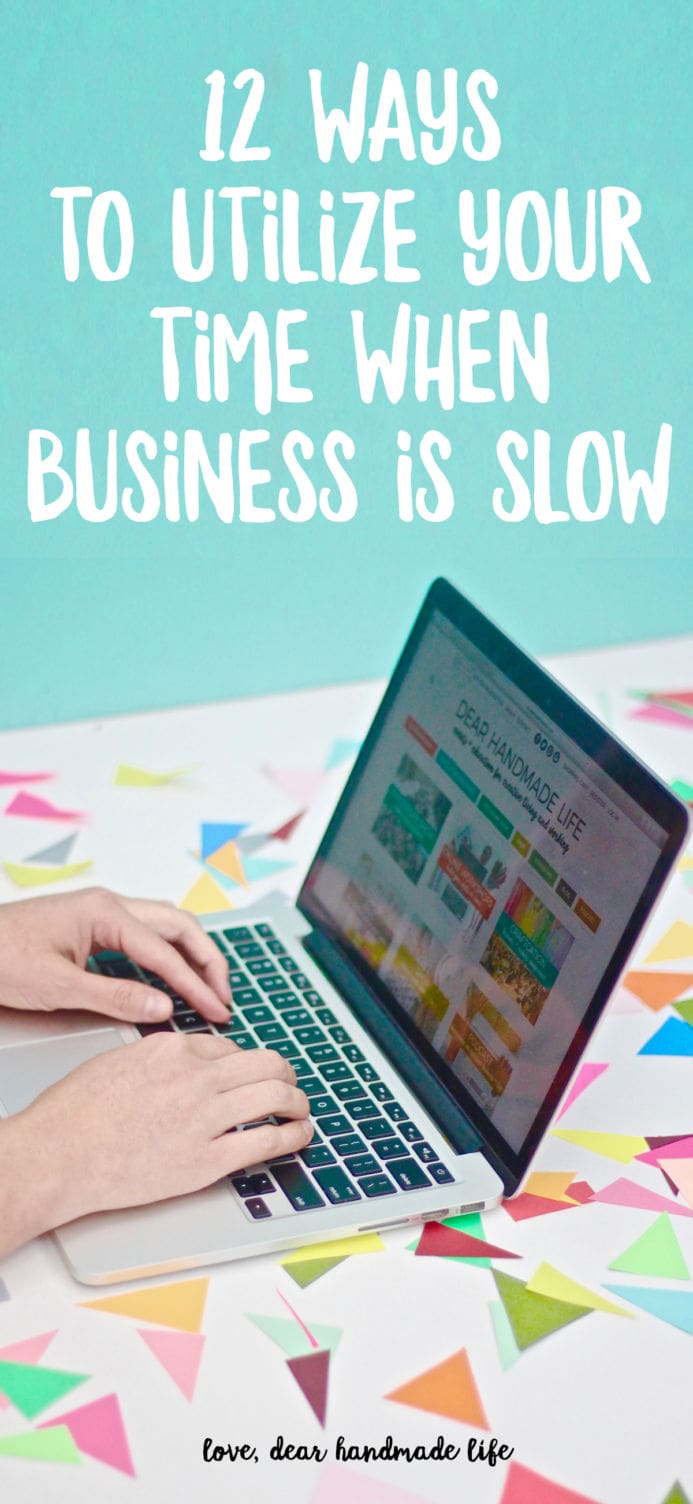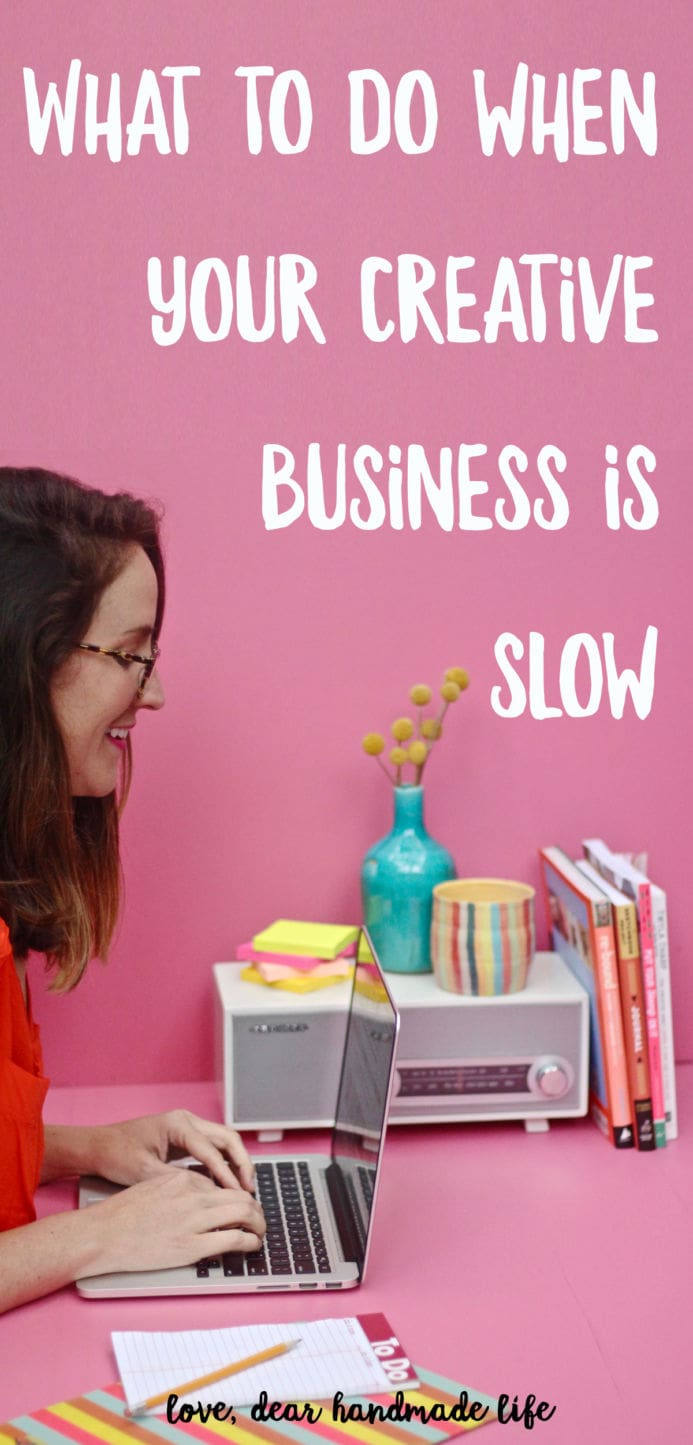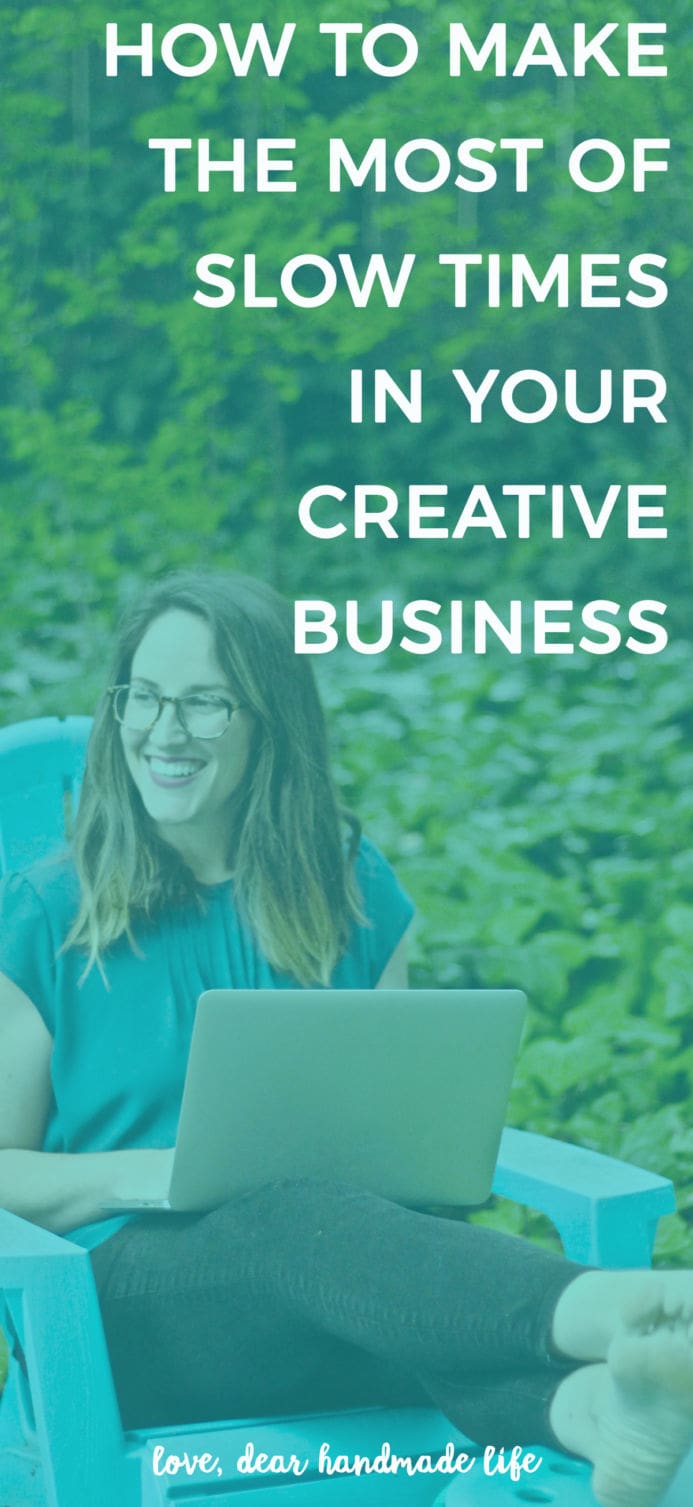What to do when your creative business is slow
I grew up in a house with the only swimming pool on our block. This meant that my childhood summers at our house were busy. Backyard BBQ’s, Bocce ball tournaments on the lawn, swimming until our fingers resembled old prunes and since we lived pretty close to “The Happiest Place on Earth” – standing on the diving board and peering up at the sky to catch a glimpse of Disneyland’s summer fireworks.
I’m lucky that summer is the slowest season for my business and (even though my own house is sadly without a swimming pool) I do everything I can to take advantage of the bits of downtime from work and warm weather. I not only spend as much time as possible outdoors and near (or in) a body of water but I also use this slower time of year to do the things for my business that I can never seem to make time for when it’s busy.
If you’re a maker or creative business owner, summer may be the slow time of year for your business as well. Spring craft shows are in the rearview mirror and you’ve got a few months before the holiday hustle begins. Whether summer or another season is your slow time, most businesses have a time of year when things are a bit calmer. Using this time wisely is essential to the long-term sustainability of your business.
Throughout the year, I keep a running list of things that I plan to do when time allows. This is key! When you think of a task, write it down, that way when the slow time arrives you’re not wracking your brain trying to remember all the things you’ve been putting off or wish you had time for.
My own summer work bucket list varies a bit from year to year but the things below are pretty consistently on my list. I’d love to hear what you do when business is slow.
Get your finances in order
If you don’t do daily, weekly or monthly accounting for your business (which we all know we should but most of us put off), this is the perfect time to start preparing for your taxes. I also use time this time to do an in-depth evaluation of how my business is working (or not working) financially. I take a close look at my expenses and income. I analyze where my money is coming from and start to devise ways to grow my income the following year. For example, if you notice that sales are low for a certain product but high for another, you’ll want to think about why. You may want to make more items similar to your best-selling product and think about eliminating your low-selling product.
If you don’t have a savings or retirement account set-up, think about using something easy to start saving. I use Acorns. I was shocked at how easy it was to squirrel away a few dollars here and there and at how fast it added up. Acorns is by far my favorite savings app.
This is also the perfect time to evaluate your pricing structure and your cost of materials. If you’re a craft blogger or handmade business owner, you REALLY need to be buying your supplies wholesale and should consider setting up a wholesale account with a company like Darice. Darice caters to small business owners and makers with low minimums and a freight-included program. Plus they just started carrying fabric! Your profit margin will never be high enough if you’re paying retail for supplies. If you’re not ready to start buying wholesale, at least make sure you’re getting the best retail price possible. Darice has a sister business Consumer Crafts that has excellent prices. For more on how to price your products, check out this post.
Set goals, plan and strategize
I’m a goal-setting and planning lover, so I do lots of strategizing throughout the year, but in the summer I set aside extra time to dream about the future, figure out what I want and create action plans. I highly suggest keeping a goals list going throughout the year and setting aside some time when your business is slow to go through that list carefully and figure out what you want to work towards and when and how to get started. If you’re not sure where to start, consider letting your creative side take over and make a vision board which will help you start (literally) seeing what dreams you have in mind for your business. Here’s a post I wrote on how to make a vision board and my experience with them. Here are a few more goal-setting posts to help you as well: How to set goals you’ll accomplish, How to set intentions and accomplish your goals and S.M.A.R.T. goal setting.
Build your community
I meet tons of creatives in person at conferences and workshops as well as online in creative business Facebook groups etc. and there never seems to be enough time to follow up with them and create a deeper connection. Summer is my time to set up coffee or cocktail meet-ups with them. If they live far away, we do it over Skype. Here are some posts we wrote to help you build your community: How to make the most out of networking events, How to network at a creative conference, How to build a support system for your creative business and The importance of off-line networking.
Build your skills
Even though I’ve been running my own business for over 15 years, there’s still SO much to learn. The more I learn, the more I realize that is for me to learn. I use my slow time to build my business skills through taking online classes. We have a few: Craft Show Success, Photo Styling 101 and Sketchbook Adventures. I also love my Creativebug subscription for building my art and craft skills and CreativeLive for business classes (you can check out my CreativeLive class Craft Show Secrets here). Aside from online classes, I catch up on podcasts I love. I’m a bit biased but our podcast has tons of great interviews and advice for creative entrepreneurs. I have lists of podcasts here and here.
Seek help
Once you begin creating your goals list and strategizing, you may start feeling overwhelmed or don’t know where to start. That’s where seeking help from a seasoned professional comes in. I didn’t hire my first business coach (Tiffany Han) until I’d been running my own business for over a decade. It wasn’t that I didn’t want to, it was that back in those days, I didn’t even know coaches that could guide creative business owners existed. Hiring my first coach was some of the best money and time I’ve ever spent on my business. Among other things, Tiffany helped realize what I needed to let go of to move my business forward. I also highly suggest Meighan O’Toole who I hired for online presence consulting. We also offer consulting for makers and creative entrepreneurs.
Research attending in-person events
Oddly, when we planned the conference we produce, Craftcation: Business + Makers Conference, I had never attended a conference before! Back then, there were only a few conferences for creative entrepreneurs and I didn’t know about any of them. After our first year producing Craftcation, we knew that we had to attend a conference since we really don’t get to take classes or experience Craftcation the way attendees do. Investing the time and money into flying across several states and being away from our business was scary but it was one of the best things we did for our business. The things we learned in the classes and the people we met, continue to shape our business nearly four years after we attended! Taking that time away for our business was so impactful that we promised to attend a conference every year! I shared my thoughts on how attending a conference will revolutionize your business and creativity here.
Take care of yourself and your personal life
This is something that’s really hard for me to do during our busy time of year. I know I should make time throughout the year to, for example: go to the gym, get my teeth cleaned, do yoga, sew or craft, stretch, take a bath, go to the dentist, write a letter to a friend etc. This list could go on for pages! When we’re in our event season, we’re working 16-hour days for most of the week and I’m lucky if I shave my legs once a month! So things like tackling an ever-growing pile of thrift store dresses that I want to tailor is way way way at the end of my to-do list. Last summer I made a commitment to stretch for 10 minutes a day. Surprisingly, when the summer was over I not only found a way to make time for daily stretching but also extended this routine to 30 days of yoga! By the end of the summer, breathing and stretching had become a habit and I found myself switching my schedule around and letting go of things that I thought I ‘had to’ do to make the time for the thing I wanted to do. Turning a slow-time activity into a habit doesn’t just work for exercise. If (like me) you always put off doctor and dentist appointments, make a plan during your slow time to make one or two appointments per month. Taking care of yourself will become a habit. Here are a few posts we wrote on self-care for creative business owners: Self-care tips for creatives who work from home and Why taking time for self-care makes your business stronger.
Take a break (or a vacation)
I spent several years hearing Craftcation attendees talk about how amazing Ventura (the lovely beach town where we hold Craftcation every year) is but I never really got truly experience it myself. I rarely have time to leave the hotel and take advantage of all the awesomeness Ventura had to offer. I always left Craftcation regretting that I hadn’t eaten at a restaurant our attendees raved about or even taken a few minutes to feel the sand between my toes or the salty sea rush over my skin. So, on my 40th birthday, I rented a beach house in Ventura and invited family and friends to join. I’m happy to say that I spent nearly all of the four days I was there totally relaxing. Among all the amazing food and drinks, I also brought my watercolors down to the beach and spent HOURS working in my sketchbook, had those kind of deep meaningful conversations with friends and family that make you burst with gratitude for being alive and left feeling not only recharged but full of ideas and excited to get back to work. If an actual vacation isn’t in your budget, consider a staycation. Hide your laptop (lock in a safe if you have to!) delete social media from your phone and stay at your house as if you were on vacation. Explore your town the way a tourist would. Check out this episode of our podcast where we chat with Aida Mollenkamp about destinations for creatives.
Work on passion projects
When you turn your passion into your business like most creative business owners do, you can get burnt out and loose sight of your love for your creative pursuit. It’s happened to me and pretty much every other creative business owner I know. The minute paying your rent or mortgage relies on your creativity, you loose some of the spontaneity of the lovely process of making. Take your slow time to tackle that creative project that may have no obvious connection to your business or financial goal/endgame. Want to take a series of photos of random things in your neighborhood that you see while walking your dog? Do it! Want to start baking a cake a week? Do it! Want to start collecting seashells and writing about where you think they’ve been? Do it!
Review your online presence
Creative business owners should be reviewing our online presence (website, blog, social media profiles, Etsy shop etc.) throughout the year. I keep records that I update and review monthly of our online presence through Google Analytics as well as note the number of followers we have on all of our social media outlets and every month I look at where our traffic is coming from and how it’s grown or decreased. I jot down notes on a spreadsheet about these changes and think about what we did to cause these changes. This helps me to decide where to focus my efforts. Is all your traffic coming from Pinterest? That tells you that there’s something you‘re doing right there but you should also focus on how to make this connection stronger. Is the traffic to your website from Facebook down? Take a peek at your Facebook analytics and figure out what’s changed? Which posts are doing well? Which are getting less engagement? Have a few friends (or if you can find a few strangers, that’s even better) take a peek at your website and ask them what they think about it. Is your branding clear? Does it feel current? Consider hiring an online strategist like Meighan O’Toole.
Create a contingency plan
I’ve had a slew of weird accidents that resulted in even-weirder injuries over the years. I’ve been to the emergency room WAY more times than most people I know. I’m always the only person to get food poisoning at a picnic (even though everyone also ate Aunt Jo’s potato salad). I’ve tripped over a kid’s tricycle and ended up spending months horizontally recovering from an injury to my lady parts that you REALLY don’t want to know about. Two years ago I tripped in my house while carrying a jar cut my hand nearly in half. This last injury occurred in October, right before our holiday craft show season (aka one of our busiest times of year). Once the triage nurse assured me that they could stop the excessive bleeding and that I wasn’t going to die, the first thing I thought about under those fluorescent lights in the hospital room was all the work that I had to do to make our holiday craft shows happen. There were so many moving parts and I was the only one who knew what needed to be done and how to do it. I was lucky that I have a business partner and could not only explain to her what needed to be done but also trust that she would do it. BUT the situation got me thinking about how my business would survive if I couldn’t do what I was supposed to do. After that, I began to put systems into place and take notes on how someone else could do my job in case I couldn’t. I started keeping track of every task I did on a spreadsheet and added a short description of how to do it. I also created a master list of passwords so someone could have access to our financial records, social media accounts and every other site related to my business and personal life. My next step is getting some legal documents together so that there’s no confusion on who’s in charge of what. Craft Industry Alliance has an awesome post about creating a contingency plan for your business.
Clean your space
I’d be shocked if you haven’t yet heard about the The Life-Changing Magic of Tidying Up by Marie Kondo. This isn’t a new concept. Intuitively we all know that clutter is distracting. I grew up in a house where everything was so clean that you could literally eat off the floor BUT my mother also had a ridiculous amount of in-progress projects and items that she was saving (because she knew that eventually ‘someone’ would need a soup strainer or a pair of size six hot pink heels). My mom grew up without, so she saves EVERYTHING. It’s taken me many years and many hours on a therapist’s couch to learn how to let go, not just of my emotional hang-ups, depression and anxiety but also of physical items. Things that I don’t need right now but may and could someday need. It’s hard to let these things go, especially if they hold sentimental value but, after moving nearly 20 times, I’ve reluctantly learned to let go. I now not only clean out my personal belongings every quarter but my work belongings as well. During your slow time of year, do a MAJOR clean out. If you haven’t used a craft supply in a year, let it go. Scan important papers, load them up on a hard drive and put it somewhere safe. Go through all the folders (and downloads) on your computer and trash everything you don’t need. If you think there’s a chance you may need it or aren’t ready to let it go completely, put it on an external hard drive. While we’re on the topic of hard drives… back up regularly! I back up to both an external hard drive as well as a cloud back up. This is my favorite external hard drive.






This is a really great post and good advice for all business owners. Slow times may frustrate business owners but it’s really a great time to recharge and organize your ideas and goals. Thanks! 🙂